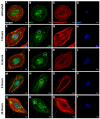A Potential New Role for Zinc in Age-Related Macular Degeneration through Regulation of Endothelial Fenestration
- PMID: 34769404
- PMCID: PMC8584935
- DOI: 10.3390/ijms222111974
A Potential New Role for Zinc in Age-Related Macular Degeneration through Regulation of Endothelial Fenestration
Abstract
Age-related macular degeneration (AMD) is a common blinding disease in the western world that is linked to the loss of fenestration in the choriocapillaris that sustains the retinal pigment epithelium and photoreceptors in the back of the eye. Changes in ocular and systemic zinc concentrations have been associated with AMD; therefore, we hypothesized that these changes might be directly involved in fenestrae formation. To test this hypothesis, an endothelial cell (bEND.5) model for fenestrae formation was treated with different concentrations of zinc sulfate (ZnSO4) solution for up to 20 h. Fenestrae were visualized by staining for Plasmalemmal Vesicle Associated Protein-1 (PV-1), the protein that forms the diaphragms of the fenestrated endothelium. Size and distribution were monitored by transmission electron microscopy (TEM). We found that zinc induced the redistribution of PV-1 into areas called sieve plates containing ~70-nm uniform size and typical morphology fenestrae. As AMD is associated with reduced zinc concentrations in the serum and in ocular tissues, and dietary zinc supplementation is recommended to slow disease progression, we propose here that the elevation of zinc concentration may restore choriocapillaris fenestration resulting in improved nutrient flow and clearance of waste material in the retina.
Keywords: PV-1; age-related macular degeneration; choroid; fenestration; zinc.
Conflict of interest statement
While SC is working for Nestlé, this work was done as part of her Ph.D. thesis, and therefore, no conflict of interest exists.
Figures






References
-
- Age-Related Eye Disease Study Research Group A Randomized, Placebo-Controlled, Clinical Trial of High-Dose Supplementation with Vitamins C and E, Beta Carotene, and Zinc for Age-Related Macular Degeneration and Vision Loss: AREDS Report No. 8. Arch. Ophthalmol. 2001;119:1417–1436. doi: 10.1001/archopht.119.10.1417. - DOI - PMC - PubMed
MeSH terms
Substances
Grants and funding
LinkOut - more resources
Full Text Sources
Medical
Research Materials

